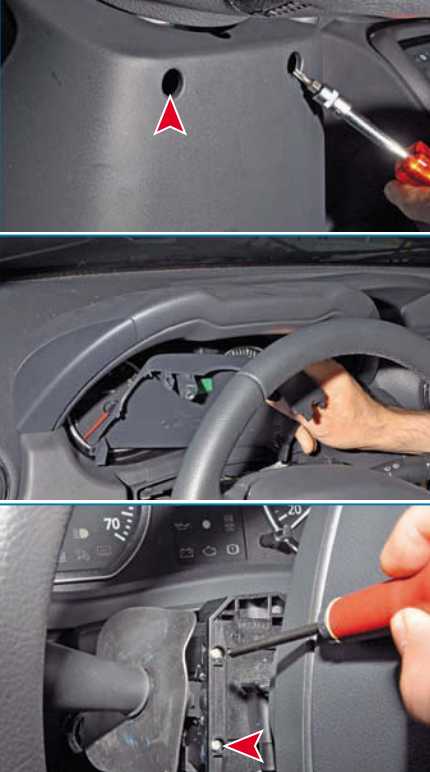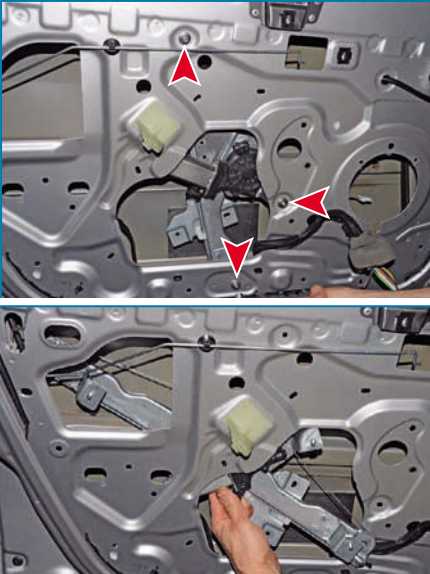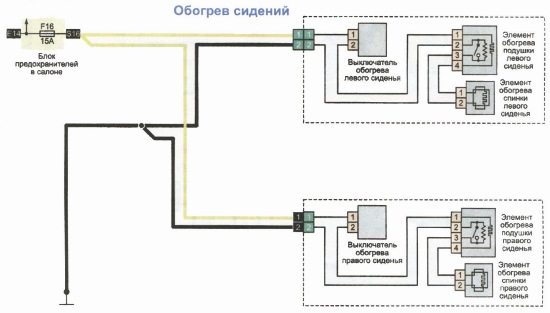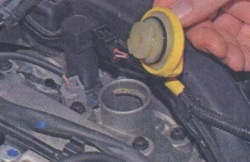Diagnostics of the state of the brake system
In accordance with the technical service schedule, the manufacturer recommends monitoring the condition of the
pads and discs of the front brake mechanisms of a Renault Duster car every 15 thousand km, and after 60 thousand km, monitor the condition and clean the rear brake pads from dust. However, during any maintenance, we recommend that you check the condition of the entire brake system of the car. We perform work on a viewing ditch or overpass.
To check the condition and degree of wear of the pads and discs, we sequentially dismantle the front wheels.
Through the caliper window, we evaluate the condition of the brake pads of the Renault Duster car.
We replace the front wheel brake pads with a set if the thickness of any pad, including its base (volume A), has reached the maximum possible thickness of 6.0 mm (see "Replacing the front wheel brake pads"). Scrolling the brake disc, we check its working planes on both sides. On the working surfaces of the disk there should be no gaps and large furrows. To measure the thickness of the disc, it is necessary to dismantle the brake pads.

With a caliper we measure the thickness of the disk, which must be at least 21.8 mm.
Placement of the marking for the minimum thickness of the brake disc.
If, as a result of wear, a high shoulder appears on the maximum diameter of the disc, which prevents accurate measurement, remove the shoulder with a file or other method, or measure the thickness of the disc with a micrometer. We replace the brake disc with shortcomings of the working planes or wear limit. The amount of wear of the brake pads of the rear wheel of a Renault Duster car is estimated by the state of its front pad, which wears out faster than the rear. For this purpose, a viewing window (hole) closed with a rubber plug is made in the shield of the brake mechanism. We take out the plug.
.and through the window we evaluate the condition of the front brake pad.
If the thickness of the pad (lining together with the base) is less than 5.0 mm, the pads of both brake mechanisms must be changed. To check the condition of the wheel cylinders and drums of the brake mechanisms, we dismantle the drums (see "Replacing the brake pads of the rear wheels"). We check the drums, they should not have breaks and chips. With an impressive mileage of the car.
measure the inner diameter of the drum with a caliper.
The marking on the drum of the brake mechanism - the inner diameter of the drum must not be more than 229.5 mm.
When the working plane is worn to the maximum possible diameter, as well as in the presence of large grooves, we replace the brake drum. To check the condition of the cuffs of the wheel cylinder sequentially, on each side.
.shift the face of the anther from the protrusion of the base of the cylinder.
In the presence of brake fluid under the cover, indicating a malfunction of the wheel cylinder seals, the cylinder must be replaced.
To check the performance of the Renault Duster vacuum brake booster, with the engine off, press the brake pedal 5-6 times and, fixing it in the depressed position, start the engine. With a working vacuum booster, after starting the power unit, the pedal should move forward a little. If this is not done or braking
insufficiently effective (the brake pedal must be pressed with high pressure), it is necessary to check the tightness of the connections of the vacuum supply line to the vacuum booster and the suitability of the booster itself. We control the condition of the brake pipes. The lines must be firmly fixed in the clamps and must not have dents, mechanical flaws, deep corrosion, or signs of brake fluid leakage. If necessary, we tighten the connecting fittings or replace faulty parts. Brake hoses must not be torn, broken or frayed. We control the condition of each pipeline by making the fluid pressure in the brake system. To do this, the assistant must press the brake pedal with effort and hold it during the inspection. The origin of rubber blisters or leakage of brake fluid from the pipeline and its tips is not allowed. If defects are found, we replace the pipelines with a set. We control the functionality of the parking brake of a Renault Duster car. The full stroke of the parking brake lever must be 6-8 teeth (clicks) of the ratchet mechanism. If necessary, adjust the parking brake (see "Adjusting the parking brake drive").
Source: http://avtorial.ru/Renault/Renault_Duster-22.html




![1 generation [2010 - 2015]](/uploads/Renault_Duster_2010-2015_.jpg)
